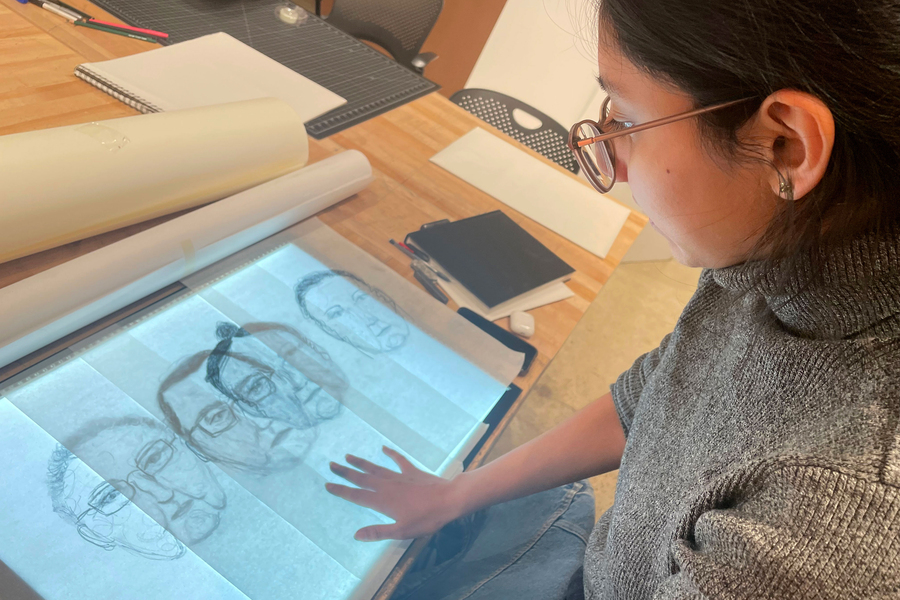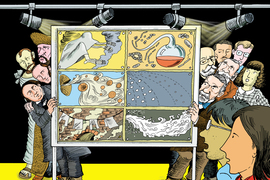On the first Friday in November, the students of 21A.513 (Drawing Human Experience) were greeted by two unfamiliar figures: a bespectacled monkey holding a heart-shaped message (“I’m so glad you are here”) and the person who drew that monkey on the whiteboard: award-winning cartoonist and educator Lynda Barry, whose “Picture This” was a central text on the new interdisciplinary course’s syllabus.
As the afternoon’s guest speaker, Barry welcomed each arrival, her long gray braids swinging, pens dangling from her neck. Within minutes, she had everyone — even the course’s instructors, anthropologist Graham Jones and visual artist Seth Riskin — settled around tables with their eyes closed, drawing giraffes.
When Barry asked participants to open their eyes and hold up their giraffes, the room filled with laughter over the menagerie of stubby legs, irregular necks, and erratic spots.
“It came out better than I thought!” one student exclaimed.
“Watching people draw with their eyes closed is fantastic,” Barry beamed. “It’s like being in the room with everyone dreaming.”
“Picture This” contends that everyone can draw; children do it unselfconsciously up to a certain age, Barry writes, but all too often conventional qualms put a stop to this expressive and deeply human practice. Jones saw evidence of this when the class convened in September.
“When we went around the room asking students what they wanted to get out of the class, about two-thirds said something like ‘I used to make art, but I don’t have time to do it anymore,’ or ‘I didn’t feel like I was good enough at it,’” he recalls. “For some students, we’ve been opening up a doorway to a set of experiences that’s been shut for a long time.”
Senior Charles Williams, a computer engineering major, counts himself among that group. “This class breathes back into you the creative and artistic expression that is too often lost as we grow up and mature,” he says.
What it means to be human
Newly offered last fall, Drawing Human Experience was supported by a cross-disciplinary class development grant from the MIT Center for Art, Science & Technology (CAST). It was co-presented by MIT Anthropology and the MIT Museum Studio and Compton Gallery.
It is the second CAST grant shared by Jones and Riskin. In 2019 they co-taught 21A.S01 (Paranormal Machines), which explored how humans can use interactive technologies to create experiences beyond everyday life. That course left them eager to delve further into the intersection of their disciplines at the most essential level.
“Drawing is deceptively simple,” Jones notes. “You can do extraordinarily complicated things with the kind of media that everybody has immediately at hand.”
The course’s syllabus opens with a declaration — “We do not accept distinctions between ‘good’ and ‘bad’ drawing” — and a hint of what students would work toward: “We draw to give our inner world outer form, to create a zone of communication between both us and ourselves, and ourselves and others.”
The course bases students’ grades on their sincere investment in investigating that zone of communication — developing their own visual language along the way — rather than a mastery of photorealistic representation.
“The difference between an ordinary drawing class and this class is that it puts the quality of mind before technical skills,” says Riskin, manager of the MIT Museum Studio and Compton Gallery (where the course met), as well as co-instructor of a long-running class on vision in art and neuroscience.
Jones is a professor of anthropology who researches how people use language and other media to perform and interact.
“On the deepest level, anthropology asks the question ‘what does it mean to be human?’” he says. “What we’re trying to do in this class is allow the students to ask this fundamental anthropological question by going very deeply into their own experience.”
The instructors divided the course into three modules: abstraction, figuration, and diagrams. In the third unit, Jones lectured on the use of diagrams in anthropology to visualize complex social structures such as kinship and gift-giving networks. “Diagrams organize thinking,” Jones told the class, “and they organize people around that thought process. They’re one of the most profound inventions in human history.”
While diagrams the students encounter elsewhere in their studies might aim for the precise presentation of facts, Riskin urged them to consider the term more expansively. “Ambiguity is a very powerful vehicle in art,” he reminded them. “If there’s not ambiguity, maybe it’s not art anymore because there’s no role for the viewer’s imagination.”
Students discussed the work of artist Christine Sun Kim, who uses infographics for social commentary, as in her series of pie charts on “Deaf Rage” that have been exhibited at the MIT List Visual Arts Center and internationally. Then they partnered up for an exercise, documenting their changing relationship with a classmate before, during, and after a getting-to-know-you conversation. The resulting diagrams resembled swirling plasma, mushrooms releasing spores, spiky plants emerging from seeds — nary an x- or y-axis in sight.
The essence of drawing
Between classes, students completed “D-Sets” (drawing-based problem sets) in the hardbound sketchbooks they’d received at the start of the semester. D-Set number four, for example, had them practice gesture drawing — employing rapid, broad strokes — while observing passersby in a public space. The goal, explains Riskin, was “not to capture the many details that accurately represent the human form, but rather in two or three seconds to capture the whole, the gestalt, of a human figure.” He and Jones designed several such exercises for “training immediacy” — an antidote to the self-critical, goal-oriented attitudes that turn many adults away from the act of drawing.
“The assignments helped me think more about drawing to convey, rather than to represent,” says junior Jaclyn Thi, a computer science and engineering major. “They made drawing much more enjoyable overall.”
While students were urged not to overthink the process of putting marks on paper, class meetings provided a social, supportive space to reflect on the results.
“The second class was kind of a shock,” Jones remembers. “We had come up with this whole plan about how they were going to exchange their sketchbooks, and we had prepared all of these prompts. But as soon as I said, ‘OK, turn to somebody next to you who hasn’t seen your work,’ the room immediately erupted in conversation. They talked for half-an-hour about the drawings, and we had to cut it off. It was like the floodgates opened.”
During a peer feedback session in week six, the students clustered around the studio’s plain wooden tables, which had been pushed together to form a large surface. They gazed down at nearly two dozen sketchbooks splayed open to the latest D-Set: gesture drawings conveying emotional connections to important figures in their lives. Some pages were covered in thick, moody smudges, while others crawled with wispy lines, and a few clean white pages bore only a few bold marks.
Several students singled out a classmate’s drawing, remarking how its confident charcoal strokes — suggesting short hair, glasses, the slight curve of a smile — managed to evoke a sense of lightness and joy. Riskin addressed the artist: “Maybe the drawing surprised you a bit because it was easy? You were just with the person and the drawing came out as an expression of that,” he guessed, eliciting a nod of recognition. “That, to me, is the essence of drawing.”
Sophomore Kanna Pichappan, a brain and cognitive sciences major and anthropology minor, looks back on that assignment as one of her most challenging. “I chose to depict Goddess Durga, a deity from the Hindu tradition who motivates me to live with courage, inner strength, and a commitment to righteousness,” says Pichappan. “I was apprehensive that my drawing might not turn out the way I envisioned. Until this class, I hadn’t even realized that a depiction of a figure’s form is not the same as experiencing the feelings the figure inspires. That D-Set helped me establish new habits: drawing what I feel, rather than what something should look like.”
Weeks later, when choosing a subject for her final project, Pichappan decided to return to exploring the goddess’s role in her life “from a place of creativity and freedom.” The course, she says, made that possible: “It helped me shift from the belief that art is created to represent something, towards the understanding that drawing can be a powerful way of deepening and enriching our understanding of our personal human life experiences.”












